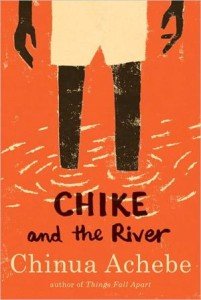
Pros: engaging African children’s story
Cons: none for what it is
At the start of Chike and the River, the eleven-year-old title character moves from the Igbo Umuofia (Achebe’s native town and the site of his breakthrough 1958 novel Things Fall Apart) to the city of Onitsha on the Niger River, living with his uncle and going to an English-language school. Though his mother warned him to stay away from the river, Chike becomes obsessed with riding a ferry back and forth across the Niger (Asaba is on the other side, not notably different from Onitsha to Chike), before a bridge renders the ferry obsolete. The problem is not the boy who does not know how to swim fearing drowning, but lack of the three-pence each way for passage on the ferry. “Chike was so anxious to find the money for his trip across the river that he very nearly went into bad ways.” –
Before he achieves his goal, which leads directly to new terror on a lorry he chose as a safe place to seep, Chike fords a stream with water up to his chest, learns to ride a bicycle, learns to play football (soccer), and observes some shady urban characters.
Achebe wrote the book for his daughter when she was learning to read (ca. 1966; it was published in South Africa, but not in the US until 2011) because she was assigned nothing not written by and about white people. It does not seem to have occurred to Achebe that to fashion something for his daughter with “characters just like her, living lives just like hers” might have related more easily to a female African character than to a male one. The male focus of his other fiction written before the catastrophic Biafra secession war recurs here.
The novella was written for a pre-teen about a pre-teen, but it has some of the same conflicts (albeit with a happier ending) as Things Fall Apart: social change in Nigeria (which became independent in 1960 and has not been well-governed as one kleptocracy has succeeded another (“black stooges” for the old masters in Achebe’s words) and Biafaran secession in 1967 was brutally suppressed).
The book includes a forerunner (by long-distance snail-mail) of young Nigerians trying to scam naïve foreigners. The American edition has mostly red and black woodblock-like illustrations by Edel Rodriguez. (His cover caught my eye in the Smithsonian’s African Art Museum. I thought I had read all Achebe’s novels and was surprised to see a 2011 one — which was really a 1966 children’s book —, so I was right that I had read all his novels, plus a collection of stories).



